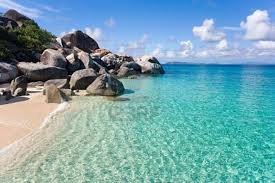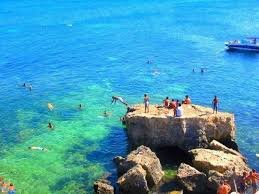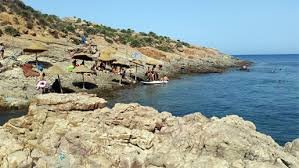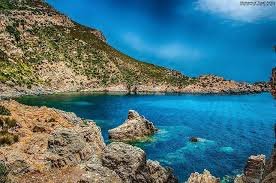El Haouaria is on the northernmost tip of Cap Bon on the Sidi Abioud Mountain. It is a fairly sleepy coastal village of around 9,000 residents with a very remote air about it. It is also known by its Roman name of Aqualaria which means “country of eagles”. The main activity in the town is on Friday, the local market day. The white-washed buildings mostly look out on the inland fields and countryside rather than the Mediterranean. Just across the water to the east is Sicily, making this one of the narrowest points between Africa and Europe.

El Haouaria is best known for supplying local red and yellow sandstone which was used in the building of Carthage. The best quality stone was at the lower levels, hence there are tunnels up to 100 feet long. The Carthaginians and later the Romans had to dig down to get the lower rocks and haul them out of the shafts. The huge blocks were shipped by barge and were usually covered with stucco to prevent the stone from weathering away. The stone from El Haouaria was also used for building tombs and has been found in some as old as the 6th century BC.
The ancient quarries are reached along the paved road, heading north from the town. After passing the house of the holy man, it becomes a sandy track which leads to a small car park. There is a small café which serves welcome drinks and snacks overlooking Zembra.



Known as Gar el Kebir the quarries draw regular coach tours to see them. These man-made Roman caves were clearly once used for prisoners, convicts and slaves who worked in the quarries. Look for the rock shaped like a kneeling camel – local legend says it is guarding treasure and leaps into life after dark.
The area is a popular resting place for migrating birds and the rugged rocky coastline is ideal for the breeding of falcons. The town’s culture is intrinsically connected to the ancient sport of falconry. The birds are taken from the nests in spring and are used for hunting quail, hare and partridge during the summer months. At the end of the summer they are set free. The skills of falconry are handed down through the generations from father to son and the sport is strictly licensed.
During May or June a three-day falconry festival is held in the Nadi el Bayazara Falconry Centre in El Haouaria, and attending it is a rare cultural treat. The birds of prey are used in contests to catch small birds and imagery of hawks and falcons can be seen throughout the town. The award of the best Falconer of the Year is a prestigious and highly sought-after title. Although the sands of El Haouaria are covered in most places with a rocky top, just along the coast at Rass ed Drak is one of Tunisia’s loveliest beaches.


Hi! I am a robot. I just upvoted you! I found similar content that readers might be interested in:
http://www.tunisia.com/el-haouaria